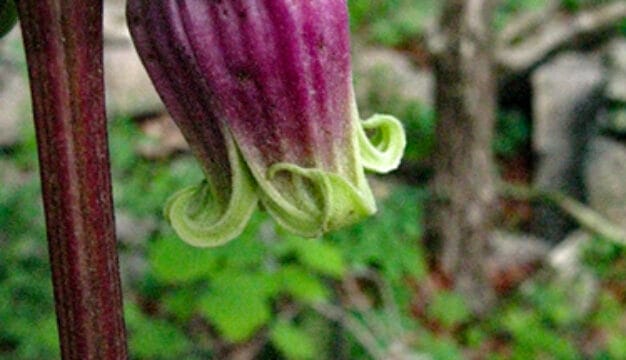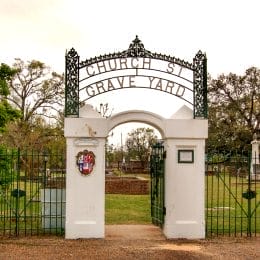Yellow Fever in Alabama
Yellow fever is a tropical and subtropical disease that had a significant impact on Alabama‘s history and early settlement. The exact origins of the disease are unclear, but historians generally believe that it evolved in Africa and spread via colonial trade to the Americas in the sixteenth century. Recorded by the earliest French settlers in Mobile in 1704, the last outbreak was reported in 1905. It earned many nicknames based on its symptoms, including Bronze John, Black Vomit, the Yellow Plume of Death, the Saffron Scourge, and Yellow Jack. The disease still claims lives in many parts of the world, but no deaths have been recorded in North America since 1905.
Yellow fever is an arbovirus infection, meaning that it is caused by a type of virus transmitted by arthropods such as ticks and mosquitoes. Yellow fever is specifically carried by the Aedes aegypti mosquito, an insect that prefers to feed on people and thus favors urban environments. Yellow fever typically lasts about a week or less. Initial symptoms include severe overall aching and high fever, sometimes in the dangerous ranges of 102 degrees to 104 degrees. After a lull in these symptoms, severe nausea, dramatic jaundice (the source of the disease’s most common name), and muscular pains can manifest. In extreme cases, victims also experienced hemorrhaging and then vomiting of semi-digested blood (“black vomit”). Severe cases can damage internal organs, with the liver, kidneys, and heart being most compromised. Death from renal failure, heart failure, or blood poisoning was common in past epidemics prior to modern medicine, but victims who experienced mild cases acquired immunities. Careful nursing care was vital to recovery in milder attacks.
The earliest reference to yellow fever in Alabama was a disease outbreak at the colonial French settlement of Fort Louis de la Louisiane in present-day Mobile in 1704. This epidemic was the only one recorded during the French colonial period in Alabama (1702-1763), possibly because yellow fever was often mistaken for other diseases. Mortality numbers for that outbreak are unknown, but its origin traces to a ship that was transporting French women to the colony and had stopped in Havana, Cuba.
During the early nineteenth century, Alabama’s rapid population growth and increased transoceanic trade resulted in a greater frequency of yellow fever outbreaks, particularly in the port city of Mobile. This influx of people had no acquired immunities to yellow fever, and the disease caused many deaths. During the epidemic of 1819, the year of Alabama’s statehood, Mobile recorded approximately 430 deaths out of a population of about 1,000. The city established the Church Street Graveyard that year to inter its many Spanish, French, and American victims of yellow fever.
Mobile grew economically in the early nineteenth century, with many immigrants settling there as the Atlantic exchange in cotton expanded. More cities developed around Mobile Bay as economic opportunities afforded new growth. Yellow fever followed that progress. In 1822, the disease appeared in Blakeley, located north of Mobile on the Tensaw River, and its population was decimated, never to recover.
In the 1830s and 1840s, many Irish and German immigrants, as well as others, arrived in coastal Alabama, and all were unacclimated to yellow fever. In an 1839 epidemic, the disease claimed approximately 450 people. To aid victims of the scourge, a group of civic-minded Mobilians created the Can’t Get Away Club. This local paternalistic relief society arranged medical care for victims in Alabama and beyond, provided medicine and provisions to those who could not afford adequate care, and also often arranged burials. The organization mirrored the Howard Association of New Orleans, which also aided yellow fever victims across the South during epidemic outbreaks.
Yellow fever continued to occur in Alabama throughout the 1840s and 1850s as steamboat and railroad travel carried people and disease across the state. In 1852, the city of Selma, Dallas County, recorded 53 deaths from yellow fever. An epidemic the following year was the worst antebellum outbreak in the South, killing 7,849 people in New Orleans alone. Mobile’s epidemic that year, which resulted in 1,191 deaths, originated with passengers on a ship from New Orleans. The epidemic ran from July to mid-December, when cold weather arrived to kill the swarms of virus-carrying mosquitoes. Spring Hill recorded several deaths, and outbreaks occurred in Montgomery County west to Choctaw County and to the south. In other locales suffering from the epidemic, 74 total deaths were noted.
Physicians in the nineteenth century did not understand how yellow fever was transmitted or how best to treat the disease. In the first half of the nineteenth century, some doctors believed that miasmas or foul emanations from putrefying animals and plants produced the fever, and others thought that person-to-person contact or bodily secretions were responsible. Treatments based on allopathic, homeopathic, and Thomsonian systems of medicine (all of which would be considered “folk or alternative” medicine now) were used by medical practitioners to treat the disease in a wide variety of methods, from blistering (the application of hot mustard or other salves to the skin) to vegetable concoctions and doses of calomel meant to induce vomiting. These were mostly ineffective against the virus. Meticulous nursing care often provided the most successful means of treating a yellow fever patient.
Alabamians continued to experience yellow fever throughout the 1860s and into the early 1870s. Outbreaks in Mobile and Montgomery were the most frequent during that time as these two cities were major transportation routes through which outsiders brought in the disease. In 1873, a severe epidemic affected Alabama from Huntsville, Madison County, in the north, south to Mobile Bay, with approximately 124 deaths across the state. The subsequent 1878 epidemic hit New Orleans (4,000) and Memphis (5,150) particularly hard. Alabama recorded approximately 250 deaths that year, many of whom were refugees fleeing other epidemic-plagued areas. Throughout the 1880s and 1890s, Alabama experienced sporadic occurrences of yellow fever. Cases and deaths were documented at Brewton, Escambia County, (1883), Decatur, Morgan County, (1888), Fort Morgan, Baldwin County (1893), and several other cities during 1897.
In 1875, the Alabama Department of Public Health was organized, mostly by members of the Medical Association of the State of Alabama, who recognized the need to combat epidemic diseases, such as yellow fever, more effectively. The state also created county health departments in each of the then 65 counties, making Alabama the first state to have health departments in every county. Therefore, when yellow fever epidemics struck in subsequent years, health departments under the guidance of the Alabama Department of Public Health were able to establish quarantine lines and issue suggestions on how best to combat the disease. Prior to 1875, the Medical Association of the State of Alabama also suggested strict quarantines as a means to prevent yellow fever. Physicians associated with both organizations through the nineteenth century also recommended preventive procedures such as distributing carbolic acid to thwart the spread of the disease. These health organizations also maintained records of statistics of epidemics collected by physicians.
With medical advancements and the introduction of germ theory in the last half of the nineteenth century, physicians and scientists began to study the biological origins of yellow fever. Mobile physician Josiah Clark Nott (1804-1873) lost four children to yellow fever in 1853 and wrote extensively on the disease. But, it was not until decades after his death that scientific study provided an explanation about the transmission of yellow fever. Epidemiologist Carlos Finlay first hypothesized that yellow fever was transmitted by mosquitoes before the Royal Academy of Medical Sciences in Havana, Cuba, in 1881. In 1900, after years of defending his theory, Finlay and an international team of scientists and physicians proved the mosquito theory. Medical pioneers Walter Reed, Aristides Agramonte, James Carroll, and Jesse Lazear worked with Finlay in Cuba to solve the mystery of yellow fever’s transmission.
The last cases of yellow fever verified in Alabama occurred in 1905, a few years after the validation of the mosquito transmission theory. Cases were noted in Castleberry, Conecuh County, Montgomery, and at the Mobile quarantine station. No deaths were recorded.
Further Reading
- Blum, Edward J. “The Crucible of Disease: Trauma, Memory, and National Reconciliation during the Yellow Fever Epidemic of 1878.” Journal of Southern History 69 (November 2003): 791-820.
- Huffard, R. Scott, Jr. Infected Rails: Yellow Fever and Southern Railroads Journal of Southern History 79 (February 2013): 79-112.
- Humphries, Margaret. Yellow Fever and the South. New Brunswick, N.J.: Rutgers University Press, 1992.






